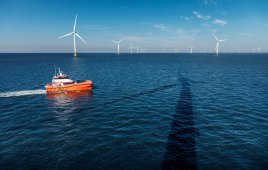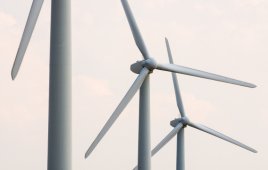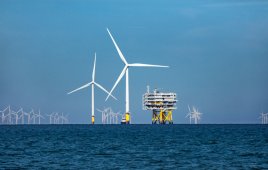Paul Dvorak / Editor
Several recent ideas that promise to make wind farms more profitable include the possibility of wind turbines that learn, on-demand guidance for maintenance and troubleshooting, and a turbine’s perfectly performing digital twin.
The recent cost of wind turbines have stabilized after a significant reduction over the past 15 years and will likely remains so through 2017 if our consultants’ crystal balls are accurate. The good news is that each new model brings another bump up in reliability. For instance, one recent 2.3-MW turbine boasts of having no slip rings. Fewer components generally spell lower maintenance costs.
Although such effort will also continue to remove cost from towers, control equipment, and other components, if the price of wind-generated power is to drop further, it will be necessary to take cost out of operations and maintenance. The recent WINDPOWER 2015 Conference dealt mostly with that issue.
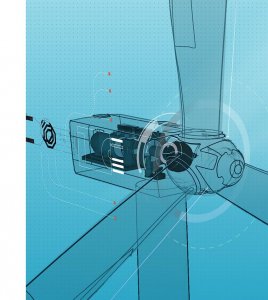
The digital twin from GE is one idea for improving wind farm O&M. For it, a physical turbine would have a perfect working digital version to which the physical model would be compared. Differences in power output, for example, would signal a turbine in need of attention.
One panel presentation in particular, chaired by UpWind Solutions CEO Peter Wells, dealt with advanced ideas for taking cost out of O&M tasks. “LCOE for the wind industry has dropped by over 50% in the past five years, with some of this reduction coming from improved OPEX – lower operating expenditures,” said Wells. “Even so, many asset owners continue to look for further reductions in OPEX, by 20% or more, especially in this post-PTC era.”
The presentations in Wells’ session discussed the O&M areas that are most ripe for exploration, such as the possibility of turbine’s learning, on-the-spot training, and one OEM’s take on building a smarter wind farm.
Where it’s possible to cut costs?
Bloomberg New Energy Finance’s Dan Shurey suggested that the average LCOE of unsubsidized U.S. power was at $48/MWh while the PTC was in effect, but that figure will rise to $60 with the end of the tax credit. Shurey predicts that it will be $65.5/MWh in 2017, $27/MWh above forecast realized revenue in this year. (Realized revenue is the effective revenue an average wind project would receive, considering the correlation between average hourly and seasonal wind speed characteristics and average hourly/seasonal power pricing). In other words, the levelised cost of wind will be higher than the average revenue wind receives, without a PTC.
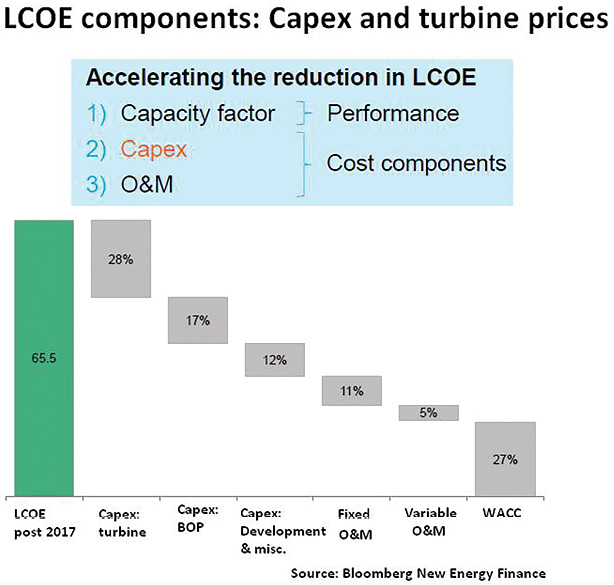 Some gains will come from new technology. For instance, his analysis of average global capacity factors showed that efficiency improvements have raised capacity factors by about three percentage points through 2015. However, combine that with increased hub heights, and the capacity factors jumped to 34%. The implication is that complex engineering solutions are not always needed to improve production.
Some gains will come from new technology. For instance, his analysis of average global capacity factors showed that efficiency improvements have raised capacity factors by about three percentage points through 2015. However, combine that with increased hub heights, and the capacity factors jumped to 34%. The implication is that complex engineering solutions are not always needed to improve production.
Shurey’s initial illustration LCOE components: Capex and turbine prices show a breakdown of the LCOE into several categories. The latter three account for 53% of LCOE after 2017, with the weighted average cost of capital (WACC) being the largest. In non-accounting terms, WACC is the rate that a company is expected to pay on average to all it security holders to finance its assets.
So how can technology improvements help reduce O&M costs? Shurey has several ideas. For example, by automating service and condition monitoring, by fault prognosis and machine learning, and by increased competition for O&M services that come from OEMs, ISPs, and in-house O&M teams. It’s also possible to improve turbine availability with efficiency gains, and downtime reductions that could come from non-disruptive inspections and fixes. Further O&M reductions can come from dynamic and real-time smart scheduling of O&M tasks. To reduce the WACC, a huge portion of opex costs, he suggests reducing the risk of failure of major components and a steady cash flow.
Harnessing big data
There is a lot of buzz around the idea of big data. The sense is that one day, mining huge quantities of data generated by wind turbines and surrounding facilities might provide actionable information. But GE’s Andy Holt said that useful information from big data is here and now. “The process is complicated, but the information the site manager needs is simple.” With that, Holt introduced the concept of the digital twin. “It’s not a complicated concept. The idea is that the digital twin would be producing a predictable and optimal amount of power given the wind and weather conditions at the moment. If the physical twin is not producing a similar amount, then it needs a technician’s attention.
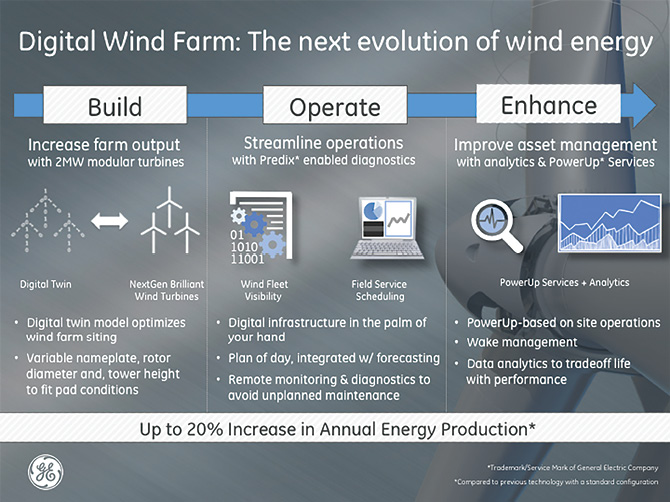
The new 2-MW platforms from GE now include Digital Twin controls. Combining hardware, software, and data analytics is one way to boost AEP, suggests the left panel in the slide. Other improvements to operation and future enhancements are coming. The company says it commissions a turbine every two hours.
“Each turbine we install and commission today has a digital twin. The amount of processed data is enormous when you consider at a single wind farm we can now install up to 20 different turbines by varying the tower heights, generator ratings, and different blade lengths, all with the same machine head. So while optimizing a wind turbine is good, optimizing a wind farm is better.”
Holt suggests that great changes are coming to the technician and site-manager level. “They will have tools to help them do things better that day. For instance, they would receive a list of actionable items that lets the site manager examine it and say, ‘we should climb turbines 7 and 9 today because those machines are asking for attention.’”
Sounds great, but does it work? GE has already tested part of this concept with its PowerUp Services, a combination of hardware and software improvements that increase AEP on existing turbines. Holt says the company has implemented PowerUp on about 4,000 turbines globally so far – one of the best performing sites generated an 8% AEP increase over last year.
“So when the newest 2-MW configurations come out, such as the 2.0-116 and 2.3-107, they will be easy to service in big nacelles thanks in part to big data.”
While his presentation pointed to a productive future, Holt added that the wind industry as some catching up to do. “For instance, in oil & gas industries, 95% of outages are planned versus 5% unplanned. In wind today, the percentages are 50-50. We have to improve that.”
On-the-spot training and troubleshooting
Wind technicians receive a good deal of classroom and hands-on training before an operator lets them go up tower. Should they encounter an unfamiliar condition, they may phone their supervisor or a more experienced tech. But if that person is unavailable, what then?
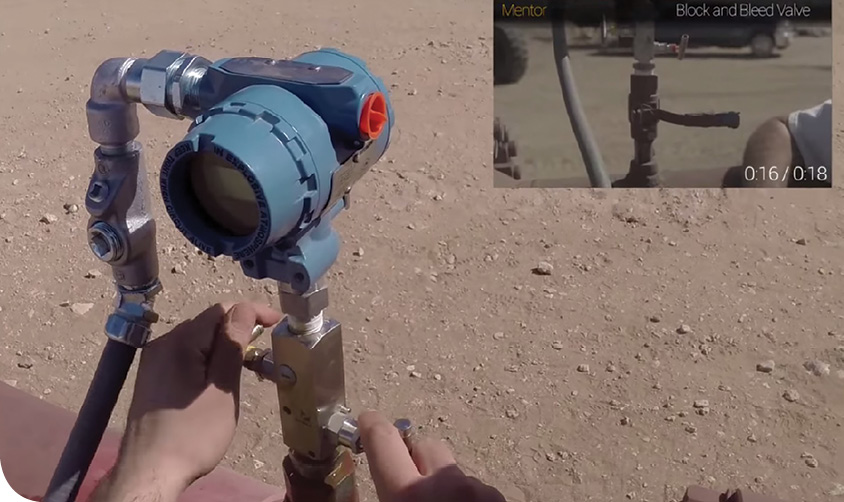
A technician faced with an unfamiliar task and access to a database through Ryan Junee’s Wearable Intelligence, could ask the database for assistance with specific voice commands. Using Google glasses, the worker would see and hear instructions for a particular task, such as blocking and bleeding a specific valve.
Founder and President of Wearable Intelligence Ryan Junee has ideas and an application for Google glasses, along with other devices such as phones and tablets because they provide instant information. But Junee says the glasses work best.
For his presentation, Junee showed a video to demonstrate the potential of instant information to oil-field workers performing non-routine tasks, such as clearing pipelines by carrying out a long sequence of instructions. The video shows a small but readable screen that the Glasses present the wearer.
The worker then talks to his information base with commands. For example, the worker initiates the instructions with the command: “Mainline,” and the system responds with information, such as that the Mainline valve is open. The sequence continues with other commands, to which the system responds with more information, sometimes with a real-time pressure reading or other technical data. The software is intended for collaboration of workers in remote field locations, such as wind technicians.
In the video, the field-site manager made an insightful comment: “We are in the middle of nowhere and yet we have information at our fingertips.” This is significant because the time it takes to acquire information also has a cost.
Capability of this sort could let experts remotely view what the worker sees, and chat with the worker doing the procedure.
The software behind the development, called Director, comes from Junee’s company. It is navigated with voice commands and head gestures. He says it also captures in-field data in the form of dictated messages or point-of-view perspective photos and recorded videos.
The software also records extensive metrics for workforce analytics, such as the length of time taken for the operator to complete each step, which can be used for audit, compliance, and continuous improvement.
What if wind turbines could learn?
Artificial intelligence is hot topic today and likely to get hotter. Letting machines learn or anticipate from their “experience” would be one application for the possibilities presented by Microsoft’s Director for Machine Learning and Data Science Solutions Vijay K. Narayanan. He suggested several reasons to let wind turbines learn.
For instance, let a machine learn behavior when:
- It cannot be coded, such as learning to recognize speech, images, or gestures, as when troubleshooting a problem.
- It cannot be scaled, such as making recommendations for maintenance.
- The machine has to adapt to an unusual situation. What could be more unusual than variations in the weather?
Also, learning a behavior would be useful when it cannot be tracked. Narayanan’s example here was for artificial intelligence in gaming and robot control.
Although Narayanan was short on wind-industry examples, it is not difficult to see a few applications to the wind industry. And at this point, it’s easy to see his presentation crossing into others. For example, GE’s Digital Twin sounds as if new turbines can already learn. This is likely the first step to machines fixing themselves or at least helping diagnose their ailments. One suspects that wind technicians will not complain too much if they can avoiding one 100-m tower climb each day.
For machine control, monitoring and alerting may be interesting. “At Microsoft, we have thousands of users. How will we track their data? Background monitoring could track the health and availability of company services,” according to Narayanan.
An operator’s perspective
Crystal balls and untested tech are fun, but what about the real world? EDP Renewables Brian Hayes brought the operator’s perspective to the panel.
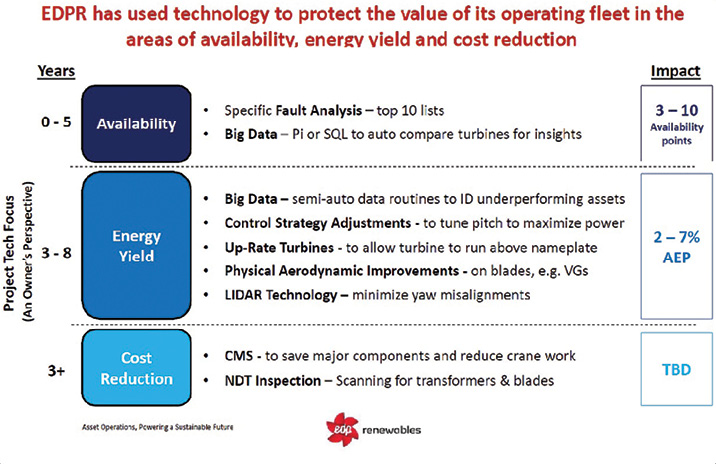 He said the challenge is to simply find which turbines are offline, need repair, and are underperforming. “Getting much more proactive with offline and faulted turbines has enabled us to improve availability. We use statistical comparisons of one turbine to another to identify poor performing turbines,” he said. The company estimates gaining 3 to 10 points in availability by using data to focus efforts on turbine performance,” he said. From 2010 to 2011 the company focused on efficiency, how to get more power out of turbines. Some improvements came from software, such as improving pitch-control algorithms.
He said the challenge is to simply find which turbines are offline, need repair, and are underperforming. “Getting much more proactive with offline and faulted turbines has enabled us to improve availability. We use statistical comparisons of one turbine to another to identify poor performing turbines,” he said. The company estimates gaining 3 to 10 points in availability by using data to focus efforts on turbine performance,” he said. From 2010 to 2011 the company focused on efficiency, how to get more power out of turbines. Some improvements came from software, such as improving pitch-control algorithms.
EDPR has also considered and made airfoil modifications because not all blades types are optimized at the factory. “We see opportunity particularly on machines from 2007 to 2012 and are experimenting with vortex generators, chord extensions, those types of things,” says Hayes. Physical adjustments mean going back to the data to determine what gains have been made. “It is difficult because there are lots of variables and data,” he says.
Then there is the recent lidar technology for identifying a yaw misalignment. How to make best use of it will also take some research and testing,” he suggests.
On cost reductions, the thing EDPR is really excited about is condition monitoring. “We took a big step this last year by retrofitting turbines that are five years old and out of warranty with CMS systems. Results have been extremely positive. For certain projects, the payback is almost complete on the CMS equipment,” he said.
Technology has also had a meaningful impact to test and inspection work. “We are using Infrared (IR) scans for transformers and other high voltage connections. There is also technology available for conducting an IR scan of rotating blade that would identify its hot spots and where repairs are needed, all without taking the turbine offline. So there is a lot of other technology coming on and we are examining how we might embrace it.”
For a digital copy of the entire August issue of Windpower Engineering & Development, pick here: http://goo.gl/9dlckH
Filed Under: Featured, O&M, Training

